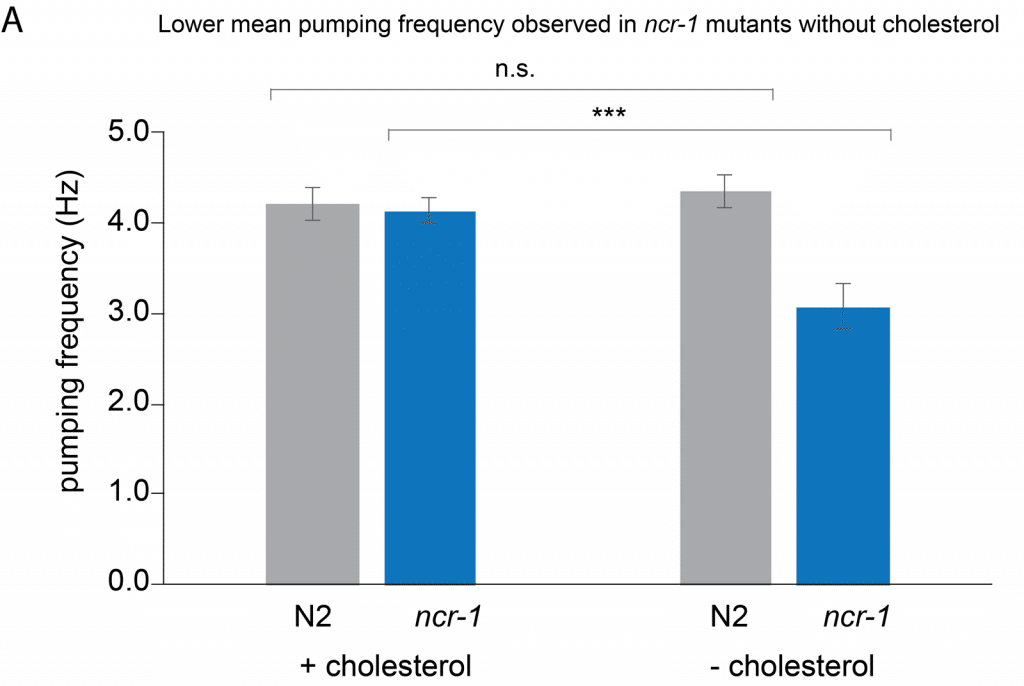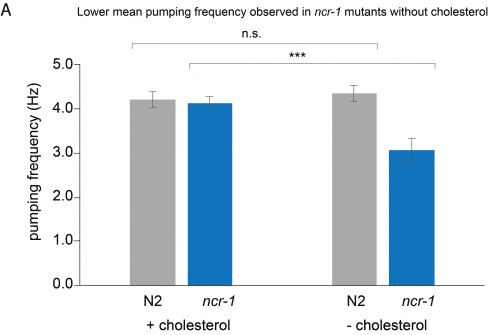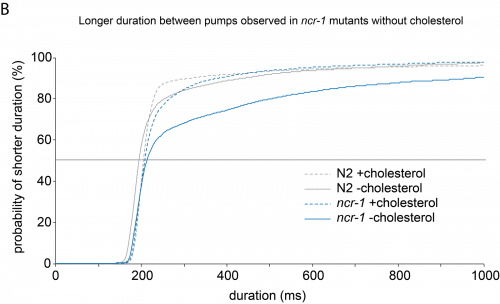Effects of Cholesterol on New NPC Disease Phenotype
We discovered that in the absence of cholesterol, NPC mutants display a lower pharyngeal pumping frequency and a longer duration between pumps than control N2 animals (see Figure 1).
Collaborative C. elegans Research Progress on Nieman-Pick Type C
This is the progress we made in our collaborative research project with Perlara and investigation into the lysosomal disorder, Niemann-Pick Type C (NPC). Previous to this work, known phenotypes for C. elegans NPC models (ncr-1 mutants1) included slowed growth, small brood sizes, tendency to enter the dormant (called dauer) stage and a higher incidence of mortality in larval stages. It was also known that these NPC models display sensitivity to a lack of cholesterol2. Our new data supports this and adds this new phenotype.
Pharyngeal Pumping Analysis in C. elegans NPC Models
Figure 1. We measured pharyngeal pumping in first day adult ncr-1 mutants (C. elegans NPC disease models) and control N2 worms in the presence and absence of cholesterol. A) We observed a significant reduction in mean pumping frequency for ncr-1 mutants deprived of cholesterol (***p < 0.0001); no difference was observed for N2 worms with and without cholesterol. B) A cumulative distribution plot of inter-pumping interval reveals that ncr-1 mutants without cholesterol also displayed longer duration between pumps; median values (indicated with horizontal grey line) for N2 and ncr-1 -cholesterol are significantly different (p < 0.05). Data from four experimental days are pooled and samples sizes are as follows: n= 32 (N2 +chol), 52 (N2 -chol), 55 (ncr-1 +chol), 46 (ncr-1 -chol).
Since nematodes need cholesterol but do not produce it (like we do), they usually acquire it from their food: decomposing plant material3. Since we do not provide them with decaying leaves, we grow worms on agar plates that contain a small amount of cholesterol. In this experiment, we measured pharyngeal pumping in worms grown (from L1 to first-day adult) on plates with cholesterol as well as plates made without the addition of cholesterol.
The lack of cholesterol affects pharyngeal pumping in ncr-1 mutants. Pumping in these worms is significantly different than all other treatments (i.e., N2s grown +/- cholesterol and ncr-1 mutants + cholesterol). With this phenotype established, we can move forward to test potential drug treatments for NPC.
One more thing: the EPGs themselves also look strange in these ncr-1 mutants – but we’ll post more about that later!
1) Sym et al., 2000
2) Li et al., 2004
3) Frezal and Felix 2015
Enhance your research capabilities with InVivo Biosystems’ premium transgenic services. We would be delighted to receive your inquiry regarding our services.



